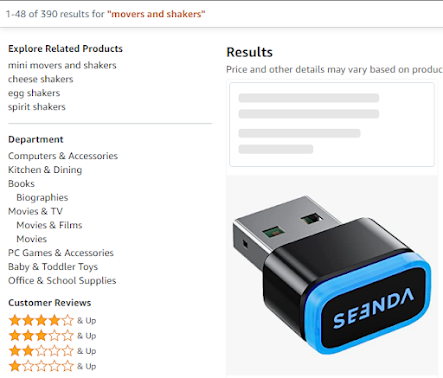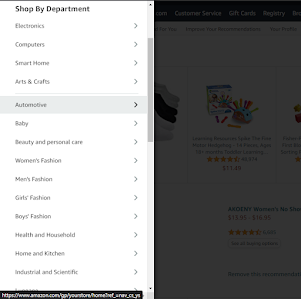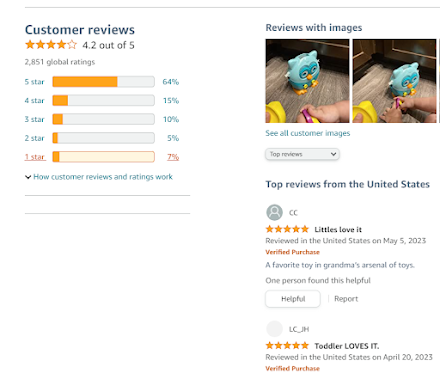Finding product ideas on Amazon can be an exciting and rewarding process. With millions of products available on the platform, there are end...
Finding product ideas on Amazon can be an exciting and rewarding process. With millions of products available on the platform, there are endless possibilities for discovering new and innovative ideas. Whether you're an aspiring entrepreneur, a seller looking to expand your product line, or simply seeking inspiration, Amazon offers several techniques to help you find product ideas.
By exploring best sellers, checking out new releases, analyzing customer reviews, conducting competitor research, leveraging social media and influencers, and utilizing Amazon's recommendations, you can uncover hidden gems, identify market trends, and gain insights into customer preferences.
These techniques, when combined with your creativity and market research, can guide you towards finding unique and profitable product ideas that resonate with your target audience.
So let's dive in and explore the different techniques to find product ideas on Amazon.
Quick Guide
1.Best Sellers:
2.Amazon's Movers & Shakers:
3.Product Categories:
4.Customer Reviews:
5.Amazon's Recommendations:
6.Competitor Analysis:
7.Keyword Research:
8.Amazon's New Releases:
9.Social Media and Influencers:
Conclusion:
1.Best Sellers:
Exploring the "Best Sellers" or "Amazon Best Sellers" section on Amazon is a great way to discover popular and high-demand products. Here are the steps to find best-selling products on Amazon:
Visit Amazon's website: Go to www.amazon.com or your country-specific Amazon domain.
Navigate to the "Best Sellers" page: Look for the "Departments" drop-down menu on the top left corner of the page. Click on it and select a category that interests you. For example, choose "Electronics & Computers" for electronics products.
Select "Best Sellers": Within your chosen category, find the "Best Sellers" or "Amazon Best Sellers" link under the subcategories and click on it. This will take you to the list of best-selling products in that category.
Explore the best-selling products: On the "Best Sellers" page, you'll find products ranked based on their popularity and sales performance. You can further refine the results by choosing a specific subcategory or using the search bar to find products within your niche.
Analyze product listings: Click on the product listings to view details such as product descriptions, images, customer reviews, and ratings. Pay attention to the product's rank, customer reviews, and overall sales performance. This information will provide insights into the product's demand and potential profitability.
Note trends and opportunities: Look for recurring themes, features, or niches among the best-selling products. Identify patterns that indicate popular trends or gaps in the market. This can help you uncover potential product ideas or identify opportunities for differentiation.
Consider market viability: While the best-seller list is a useful starting point, conduct comprehensive market research beyond Amazon. Evaluate factors like competition, profit margins, manufacturing costs, and audience demand to ensure the viability of the product before pursuing it.
By exploring the "Best Sellers" or "Amazon Best Sellers" section on Amazon, you can gain valuable insights into current market trends and popular products. Remember to conduct thorough research and analysis to make informed decisions about potential product ideas.
2.Amazon's Movers & Shakers:
Amazon's Movers & Shakers is a section that showcases products experiencing significant sales rank gains within the past 24 hours. This section is helpful for identifying emerging trends and products that are rapidly gaining popularity. Here's how you can explore Amazon's Movers & Shakers:
Visit Amazon's website: Go to www.amazon.com or your country-specific Amazon domain.
Find the "Movers & Shakers" page: Scroll down to the bottom of the Amazon homepage, and under the "Let Us Help You" section, you'll find a link titled "Movers & Shakers." Click on it.
Explore the products: On the "Movers & Shakers" page, you'll see a list of products that have experienced significant sales rank gains in the last 24 hours. The products are grouped into different categories.
Choose a category: Select a category that aligns with your interests or target market. For example, you can choose "Electronics," "Home & Kitchen," or any other category that you're interested in.
Analyze product listings: Click on the product listings to view more details about each item. Look at the product descriptions, images, customer reviews, and ratings. Pay attention to the sales rank gain percentage, as it indicates the product's recent increase in popularity.
Identify emerging trends: Examine the products in the Movers & Shakers list to identify any common themes, features, or niches that are gaining traction. This can help you spot emerging trends and potentially find product ideas that are in high demand.
Conduct further research: After identifying potential product ideas from the amazon movers and shakers section, conduct thorough market research. Assess factors such as competition, profitability, audience demand, and long-term sustainability before finalizing a product idea.
Remember that while the amazon movers shakers section provides insights into products experiencing recent popularity, it's essential to evaluate the overall market and conduct comprehensive research to ensure the viability of a product idea.
3.Product Categories:
Exploring different product categories on Amazon is an effective way to find a wide range of product ideas. Here's how you can discover product ideas by exploring Amazon's product categories:
Visit Amazon's website: Go to www.amazon.com or your country-specific Amazon domain.
Navigate to the product categories: On the top left corner of the Amazon homepage, you'll find a drop-down menu labeled "Departments" or "Shop by Category." Click on it to see a list of various product categories.
Choose a category of interest: Select a category that aligns with your interests, expertise, or target market. Amazon offers a wide range of categories, such as Electronics, Clothing & Accessories, Home & Kitchen, Health & Personal Care, Sports & Outdoors, and many more.
Explore subcategories: Within your chosen category, you'll find subcategories that further narrow down the product selection. Click on a subcategory that interests you to explore the products within that specific niche.
Browse through products: Once you've selected a subcategory, you'll see a list of products available in that category. You can further refine your search by using filters, such as price range, customer ratings, brand, and more.
Analyze product listings: Click on individual product listings to view detailed information about each product. Pay attention to product descriptions, images, customer reviews, ratings, and any other relevant information that can help you assess the product's potential.
Note trends and opportunities: As you explore different categories and products, look for recurring themes, features, or niches that seem to be popular or have a high demand. This can help you identify trends and potential product ideas that align with market demand.
Conduct market research: While exploring product categories on Amazon is a great starting point, it's crucial to conduct comprehensive market research beyond Amazon. Evaluate factors such as competition, profit margins, audience demand, and market saturation to validate the viability of a product idea.
By browsing through different product categories on Amazon, you can gain inspiration and discover a wide range of product ideas. Remember to conduct thorough research and analysis to select a product that fits your target market and has the potential for success. Adjust these keywords in this paragraph best selling items on Amazon, Amazon categories, Amazon categories list, shopping categories, Amazon product categories.
4.Customer Reviews:
Customer reviews are a valuable resource on Amazon for gathering feedback and insights about products. They provide firsthand experiences and opinions from people who have purchased and used the products. Here's how you can utilize customer reviews to find product ideas and make informed decisions:
Visit the product listing page: Go to the product page of a specific item you're interested in or a product within a category you're exploring.
Scroll down to the customer reviews section: On the product page, you'll find a section dedicated to customer reviews. This section contains ratings, written reviews, and sometimes even images or videos uploaded by customers.
Read reviews: Start by reading a variety of reviews, including both positive and negative ones. Pay attention to the overall rating, the number of reviews, and the specific comments customers have left.
Look for common feedback and recurring themes: Take note of common praises, complaints, or recurring themes mentioned by multiple customers. This can help you identify areas where existing products may have shortcomings or opportunities for improvement.
Analyze the sentiment and credibility of reviews: Consider the sentiment of the reviews and whether the comments are substantiated by specific details or experiences. Focus on reviews from verified purchasers, as they are more likely to be reliable and trustworthy.
Pay attention to specific features and benefits: Customer reviews often mention specific features, functionalities, or benefits of a product. Look for mentions of unique or standout qualities that customers appreciate or dislike. This can help you identify potential product differentiators or areas to improve upon.
Sort reviews by helpfulness or specific criteria: Amazon provides options to sort reviews based on helpfulness, the most recent, or specific criteria. This can help you find the most relevant and informative reviews for your research.
Consider the overall sentiment and volume of reviews: Take into account the overall sentiment of the reviews and the number of reviews a product has received. If a product has overwhelmingly positive reviews or a large number of reviews, it may indicate a high level of customer satisfaction and demand.
Use reviews to inform product decisions: Customer reviews can provide insights into customer preferences, pain points, and potential opportunities. Use this information to refine your product ideas or make decisions about product features, quality improvements, or marketing strategies.
By leveraging customer reviews on Amazon, you can gain valuable insights into existing products, customer preferences, and potential areas for innovation. Remember to consider a range of reviews and use them as a tool to make informed decisions rather than relying solely on individual opinions.
5.Amazon's Recommendations:
Amazon's Recommendations feature is a powerful tool that suggests products based on your browsing history, purchase history, and other factors. It uses algorithms to analyze your behavior and preferences to provide personalized product recommendations. Here's how you can use Amazon's Recommendations to find product ideas:
Sign in to your Amazon account: Visit www.amazon.com and sign in to your account. This will allow Amazon to personalize the recommendations based on your browsing and purchase history.
Explore the "Recommended for You" section: On the Amazon homepage or your account's main page, you'll find a section titled "Recommended for You." This section displays a curated list of products that Amazon thinks you might be interested in based on your previous activity.
Scroll through the recommendations: Take a look at the products suggested in the "Recommended for You" section. These recommendations are based on your past searches, purchases, and similar products that other customers have shown interest in.
Click on specific recommendations: If a product catches your attention, click on it to view more details. This will take you to the product page where you can explore its features, customer reviews, ratings, and other relevant information.
Check out related recommendations: On the product page, you'll often find a section titled "Customers who bought this also bought" or "Customers who viewed this also viewed." These related recommendations can provide additional ideas and insights into products that are commonly paired or of interest to customers with similar preferences.
Repeat the process: Continuously explore the recommendations and click on products that pique your interest. As you engage with the recommendations, Amazon's algorithms will further fine-tune the suggestions to align with your preferences.
Analyze customer reviews and ratings: While exploring the recommended products, pay attention to customer reviews and ratings. This feedback can provide valuable insights into the quality, performance, and popularity of the products.
Consider cross-category recommendations: Amazon recommendations system can also suggest products from different categories that may complement your interests. This can help you discover new niches or opportunities that you may not have considered before.
Take note of recurring themes and patterns: As you explore the recommendations, observe any recurring themes, features, or product categories that consistently appear. These patterns can indicate popular trends or customer preferences that you can leverage for your product ideas.
By regularly exploring and engaging with Amazon's Recommendations, you can discover new and relevant product ideas based on your preferences and interests. Remember to analyze customer reviews, conduct market research, and validate the viability of the product before making any final decisions.
6.Competitor Analysis:
7.Keyword Research:
Keyword research is an essential part of developing a successful product or optimizing your online presence. Here are the steps to conduct keyword search effectively:
Define your goals: Determine the purpose of your keyword research. Are you looking to optimize your website for search engines, create content, or find product ideas? Clarifying your goals will help you focus your research.
Brainstorm relevant keywords: Start by brainstorming a list of keywords related to your product, industry, or niche. Think about what terms your target audience might use when searching for products or information related to your business.
Use keyword research tools: Utilize keyword research tools to expand your list and gain insights. Popular tools include Google Keyword Planner, SEMrush, Ahrefs, and Moz Keyword Explorer. These tools provide data on search volume, competition, and related keywords.
Analyze search volume and competition: Assess the search volume for each keyword to understand its popularity. High search volume indicates a higher potential for visibility and traffic. Evaluate the competition level for each keyword to determine if it's feasible to target.
Consider long-tail keywords: Long-tail keywords are longer, more specific phrases that often have lower search volume but higher conversion rates. They can be valuable for targeting a specific audience and capturing highly relevant traffic.
Analyze competitor keywords: Study the keywords your competitors are targeting. This can provide insights into their strategies and help you identify gaps or opportunities. Competitor analysis tools like SpyFu or SimilarWeb can assist in this process.
Consider user intent: Think about the intent behind the keywords. Are users looking for information, comparing products, or ready to make a purchase? Tailor your keyword strategy to align with the intent of your target audience.
Refine and prioritize your keyword list: Review your keyword list and refine it based on relevance, search volume, competition, and user intent. Prioritize keywords that have a good balance between search volume and competition and are highly relevant to your business.
Monitor and update your keyword strategy: Keyword research is not a one-time task. Regularly monitor keyword performance, adjust your strategy based on changing trends and user behavior, and update your content or product optimization accordingly.
Remember that keyword research is an iterative process, and it's essential to analyze and adapt based on the results you observe. Stay up-to-date with industry trends and search engine algorithm changes to ensure the ongoing effectiveness of your keyword strategy.
8.Amazon's New Releases:
Exploring the "New Releases" section on Amazon can be a valuable way to discover recently launched products and stay updated on the latest trends. Here's how you can find new releases on Amazon:
Visit Amazon's website: Go to www.amazon.com or your country-specific Amazon domain.
Navigate to a product category: Use the "Departments" or "Shop by Category" drop-down menu on the top left corner of the Amazon homepage to select a category that interests you. This could be electronics, books, clothing, beauty, or any other category you're interested in exploring.
Look for the "New Releases" section: Once you're in your chosen category, scroll down the page to find the "New Releases" section. This section typically showcases recently launched products within that specific category.
Browse through the new releases: In the "New Releases" section, you'll see a list of products that have been recently introduced to the market. You can scroll through the products, click on them to view more details, and explore their features, descriptions, and customer reviews.
Filter and sort the results: Use the available filters and sorting options to narrow down the new releases based on your preferences. You can sort by relevance, customer ratings, price, or other criteria to find products that align with your interests.
Pay attention to customer reviews and ratings: Read the customer reviews and ratings for the new release products. This feedback can provide insights into the product's quality, performance, and customer satisfaction. It can also help you gauge the market response to these new products.
Identify trends and opportunities: As you explore the new releases, look for emerging trends, innovative features, or product categories that seem to be gaining traction. Identify potential gaps in the market that you could fill with your own product ideas or identify opportunities to improve upon existing offerings.
Consider market viability: While new releases can be exciting, it's important to conduct thorough market research beyond Amazon. Evaluate factors such as competition, demand, profitability, and audience preferences to assess the viability of a product idea before pursuing it.
Stay updated: Make it a habit to regularly check the "New Releases" section on Amazon to stay informed about the latest products and trends in your chosen categories. This can help you stay ahead of the curve and identify new opportunities as they arise.
By exploring Amazon's "New Releases" section, you can discover fresh product ideas, keep up with market trends, and stay informed about the latest offerings in your industry of interest. Just remember to conduct additional research and analysis to validate the potential of any product ideas you come across.
9.Social Media and Influencers:
Social media and influencers can play a significant role in product discovery, promotion, and market research. Here's how you can leverage social media and influencers to find product ideas on Amazon:
Follow relevant social media accounts: Identify social media accounts, pages, or groups that cater to your target market or niche. Follow accounts related to your industry, product category, or specific interests. These accounts often share content, reviews, and recommendations about new and popular products.
Engage with social media communities: Participate in discussions, comment sections, and forums where people share their experiences, recommendations, and product suggestions. Engage with the community by asking questions, seeking advice, and sharing your own insights. This can help you discover new product ideas and understand customer preferences.
Search for hashtags: Use relevant hashtags related to your industry or product category to search for posts and discussions on social media platforms like Instagram, Twitter, and TikTok. Hashtags can lead you to posts, reviews, and recommendations about products that are currently trending or gaining popularity.
Explore influencer content: Influencers often create content around product reviews, unboxing videos, and recommendations. Look for influencers who specialize in your target market or product category. Follow their content, watch their videos, and read their reviews to gain insights into popular products, emerging trends, and customer preferences.
Pay attention to sponsored content: Influencers often collaborate with brands and promote their products through sponsored content. Take note of the products they feature and the positive or negative feedback they provide. This can give you an idea of the products that are being actively promoted and endorsed by influencers.
Analyze engagement and comments: Pay attention to the engagement and comments on social media posts and influencer content. Look for recurring themes, questions, or requests from followers. This can help you identify specific product features, improvements, or gaps in the market that customers are looking for.
Follow Amazon Influencer storefronts: Amazon has a feature called the Amazon Influencer Program, where influencers can curate their own storefronts with product recommendations. Follow influential figures who have an Amazon Influencer storefront to discover their product picks and recommendations.
Utilize social listening tools: Use social listening tools to monitor conversations, mentions, and discussions related to your industry or product category. These tools can help you identify emerging trends, sentiment towards certain products, and customer needs and preferences.
Engage with your target audience: Actively engage with your target audience on social media platforms. Ask them about their favorite products, what they wish existed in the market, and any pain points they experience. This direct interaction can provide valuable insights and inspiration for product ideas.
By leveraging social media and influencers, you can tap into a wealth of information, opinions, and trends to discover new product ideas and understand customer preferences. Remember to validate your findings through further research and analysis before pursuing any product ideas.
Final Words :
In conclusion, Amazon provides a wealth of opportunities for finding product ideas. By utilizing various techniques, you can tap into the vast marketplace and discover products that align with market trends, customer preferences, and emerging demands. Exploring best sellers allows you to identify popular and high-demand products, while checking out new releases helps you stay ahead of the curve and spot emerging trends.
Analyzing customer reviews provides valuable insights into what customers like and dislike about existing products, helping you identify gaps or areas for improvement. Conducting competitor research allows you to understand the competitive landscape, learn from their successes and mistakes, and find opportunities to differentiate your own product ideas. Leveraging social media and influencers enables you to tap into conversations, recommendations, and trends within your target market.
Lastly, Amazon's recommendations provide personalized suggestions based on your browsing and purchase history, aiding in product discovery. By combining these techniques, conducting thorough market research, and using your creativity, you can uncover unique and profitable product ideas that have the potential for success on Amazon's platform.
So, start exploring, analyzing, and innovating to find the next great product idea on Amazon.
Read More:






No comments